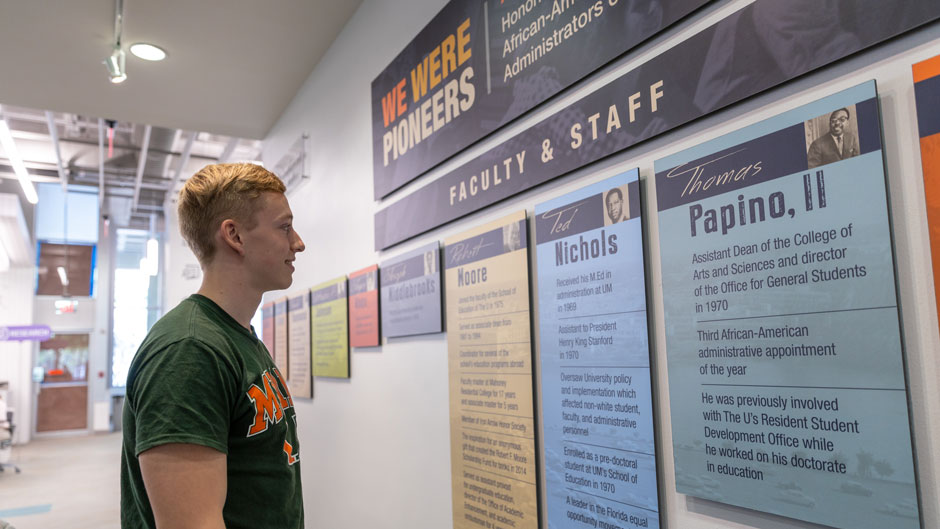What started as a single research request by the University of Miami’s Black Alumni Society to identify the first black graduates of the University had led to the University Archives’ most “successful and gratifying project” to date, said Koichi Tasa, university archivist.
In 2015, Tasa, along with Marcia Heath, a university archives technician, located a copy of “Malaika,” a handbook published in the 1970s and 1980s by the United Black Students (UBS) organization. In it were listed resources by and for the black students and faculty at the University. As they dug deeper, the pair began to unearth years of history that had been “forgotten,” said Tasa.
“We were so moved,” he said. “We began to think, ‘what we can do to help celebrate Black History Month, now that we have all this information.’”
The exhibit, “We Were Pioneers: Honoring the University of Miami’s First African-American Students, Faculty, and Administrators of the 1960s and 1970s,” takes visitors on a journey through the desegregation efforts made by the University. It took Tasa and Heath four years to put the exhibit together.
Heath described poring over old Ibis Yearbooks and University Libraries’ archives as “inspiring.” She said word of mouth proved to be a classic way to get things done when alumni reached out to her to help identify students or faculty and staff members in photos.
“Some of them actually didn’t know we had photographs of them,” said Heath, who joined the University nearly two decades ago. “We went page by page. We shared the photos with one or two people who we could identify in the photos, and then they would ask their friends to identify the others, and so on,’’ he added. “Some of them did not know how involved they were in UM history until they saw the pictures that we had.”
The comprehensive and thoughtfully curated exhibition is spread throughout the first floor of the Otto G. Richter Library, and it is showcased in four glass cases and on two wall panels. Observers are also able to interact with an audiovisual installation that includes an interview of Harold Long, the creator of the UBS.
The exhibition, managed by Tasa and Heath, has led to several university-wide collaborations since its inception.
“The effort helped us reach out and collaborate with important groups and individuals, such as the Black Alumni Society of the Alumni Association, United Black Students, Professor Donald Spivey, Dr. Dorothy Fields, the legendary alumnus Ray Bellamy, U.S. Rep. Frederica Wilson, to name a few,” said Tasa, who has been with the University since 2007.
Tasa said he has enjoyed giving tours of the exhibition over the last three years. Before its final days on display, the department will collaborate with several other areas. Recently, Tasa and his team provided assistance to Housing and Residential Life’s “The Life of Legends,” an event to honor Stanford Residential College’s last year on campus that will be held on Feb. 24 at the Kislak Center—which will feature Ray Bellamy, a trailblazer at the University, and others. Bellamy was the first African-American athlete to be awarded a scholarship to Miami, and he became the University’s first African-American student body president.
Heath and Tasa hope to be able to digitize the content featured in the casings to preserve it and have it available for historical information.
“This is not just about race,” said Tasa. “Our job is to help celebrate UM’s history and promote our values as an institution and show how the university contributed to the community.”
The “We Were Pioneers: Honoring the University of Miami’s First African-American Students, Faculty, and Administrators of the 1960s and 1970s” exhibit is open to the public until the end of February. Heath said she is delighted to fulfil loan requests made by student organizations and faculty and staff members who may want to feature the exhibit at various events around campus until its closing.
“This is important. Years from now, we may not be here. But we are proud to have successfully provided research that our successors will be able to use,” said Tasa.

